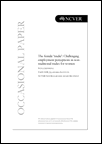Description
The place of women in the manual trades is examined in this paper, which sets out strategies for encouraging them to study and work in areas such as building and construction. Such strategies include introductory and pre-apprenticeships courses, clustering female students, and support from teachers in opening up job opportunities. This paper is the result of a 2008 NCVER New Researcher Award.
Summary
About the research
One of the main research objectives of the National Centre for Vocational Education Research (NCVER) is to build the research capacity of the vocational education and training (VET) sector. To assist this objective, NCVER has developed a program whereby new researchers are sponsored to attend its annual ‘No Frills’ conference. Four new researchers were supported to attend the 2008 conference in Launceston. One of these awards went to Fiona Shewring. This paper is based on her presentation at the conference.
The manual trades is an area where women are substantially under-represented. Despite many government initiatives over the past 30 years to open up the manual trades to women, discrimination and negative stereotypes about the ability of women to work in areas such as building and construction, boiler-making, fitting and machining, and painting and decorating have persisted.
This paper describes the experiences of 16 women who participated in training in trades not considered traditional for women at Illawarra Institute in New South Wales.
Key messages
- While it is difficult to accurately gauge the number of women in the manual trades, the number is very small, probably less than 2%.
- Employers continue to hold negative stereotypes about the ability of women to work in the manual trades.
- Women who have successfully gained employment in the manual trades tend to come from families where parents or siblings are already tradespeople.
- Strategies for encouraging women into the manual trades include: introductory and preapprenticeship courses, preferably involving work experience; clustering female students; and support from teachers in opening up job opportunities.
Tom Karmel
Managing Director, NCVER
